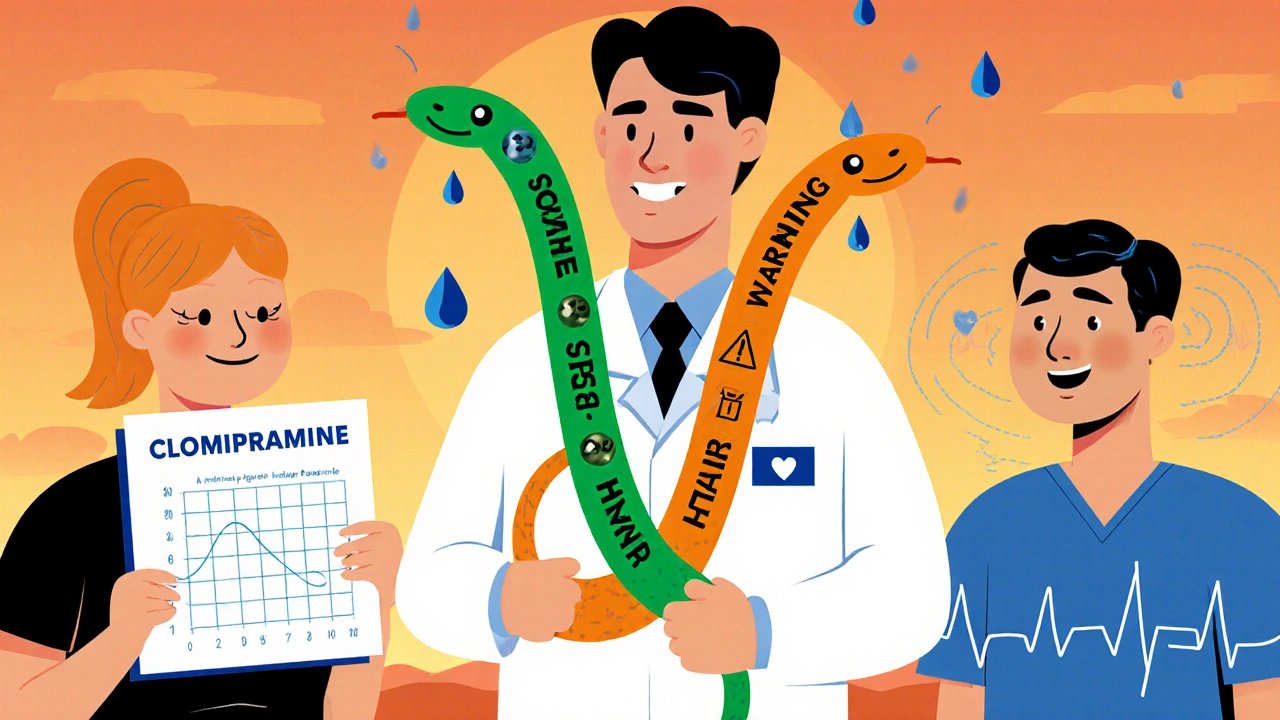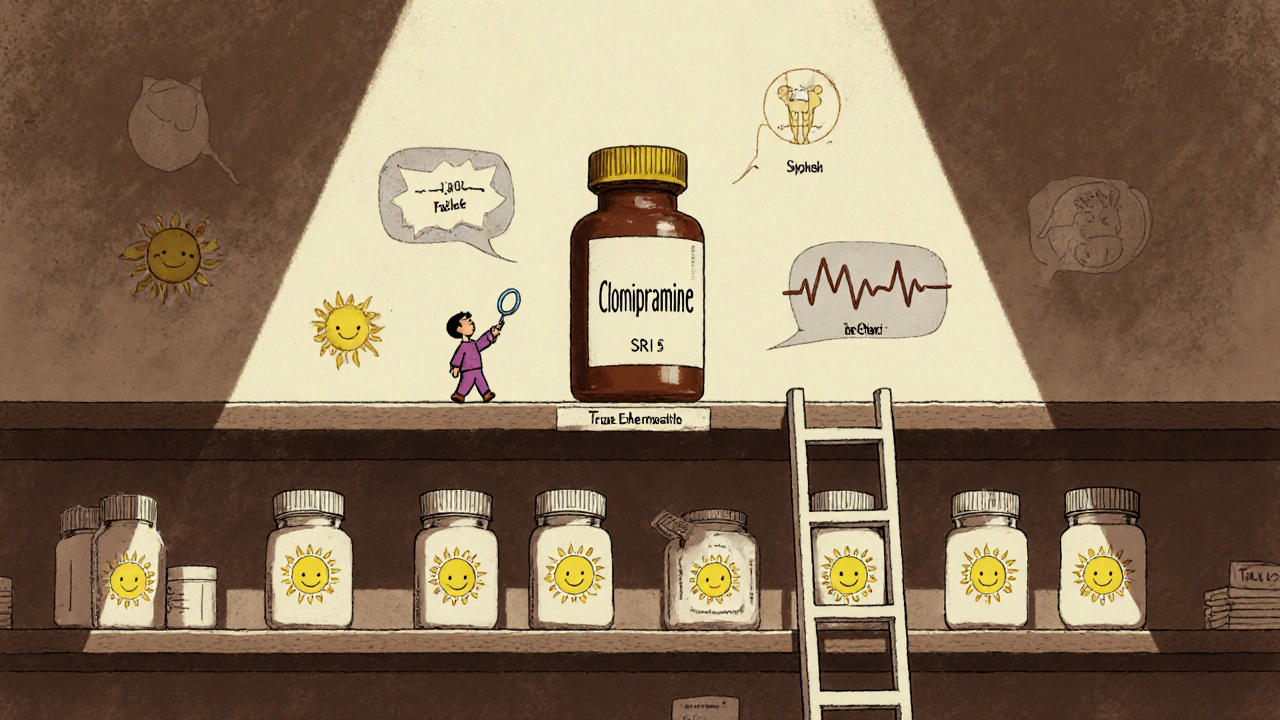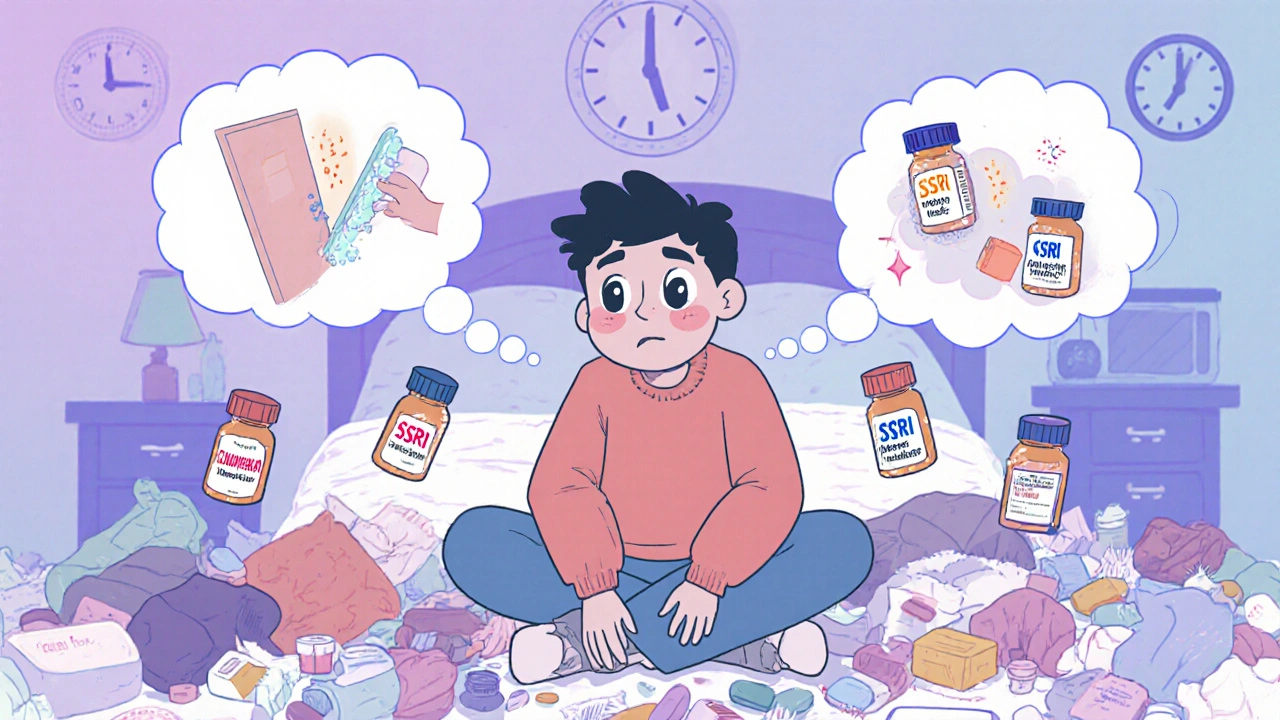When you're struggling with obsessive thoughts and compulsive behaviors, finding the right medication can feel like searching for a key in a dark room. You’ve tried therapy, maybe even exposure and response prevention (ERP), but the mental loops won’t stop. That’s when medication becomes part of the plan. And for OCD, not all antidepressants work the same. Only two classes have proven, reliable results: SSRIs and clomipramine. Everything else is either unproven or used as a backup.
Why SSRIs Are the First Choice
SSRIs - selective serotonin reuptake inhibitors - are the go-to starting point for OCD treatment. That’s not because they’re the strongest, but because they’re the safest. The American Psychiatric Association’s 2020 guidelines make this clear: SSRIs come first. Why? Side effects. Compared to clomipramine, SSRIs cause far less dry mouth, dizziness, weight gain, and heart rhythm issues. The FDA has approved several SSRIs for OCD: fluoxetine (Prozac), fluvoxamine (Luvox), paroxetine (Paxil), and sertraline (Zoloft). But here’s the twist: the doses needed for OCD are much higher than for depression. If you’ve taken an SSRI for sadness and it worked at 20 mg, don’t expect the same dose to touch your OCD. You’ll likely need 2 to 3 times that amount. For example:- Fluoxetine: 40-60 mg/day
- Fluvoxamine: 200-300 mg/day
- Paroxetine: 40-60 mg/day
- Sertraline: 200-300 mg/day
Clomipramine: The Original, But Riskier
Clomipramine (Anafranil) was the first drug ever approved by the FDA specifically for OCD in 1989. It’s a tricyclic antidepressant, not an SSRI. It works differently - it blocks serotonin and norepinephrine reuptake, which makes it powerful. In some studies, it’s slightly more effective than SSRIs, especially for contamination fears and checking rituals at doses of 150-250 mg/day. But here’s the catch: side effects. Clomipramine causes anticholinergic effects - dry mouth, blurred vision, constipation, urinary retention - at rates 3 to 5 times higher than SSRIs. It can also lengthen the QTc interval on an ECG, which raises the risk of dangerous heart rhythms. That’s why doctors don’t start with it. Dosing for clomipramine is precise and slow:- Adults: Start at 25 mg/day. Increase by 25 mg every 4-7 days. Target: 100-250 mg/day. Max: 250 mg/day.
- Teens (10+): 1-3 mg/kg/day, max 250 mg/day (Mayo Clinic says max 200 mg for kids).
- Elderly: Start at 10 mg/day, go up slowly to 30-50 mg/day.
Which One Works Better?
You might think clomipramine is the “stronger” drug. And in some ways, it is. A meta-analysis found it improved OCD symptoms by 37% in kids and teens - better than sertraline, fluoxetine, or fluvoxamine. But in adults, head-to-head trials show they’re about equal. So why not just use clomipramine for everyone? Because of the numbers. - 28% of people stop clomipramine because of side effects. For SSRIs? Only 15-18%. - On Reddit’s r/OCD, 43% of users who tried clomipramine quit due to side effects. Only 18% quit SSRIs. - On Drugs.com, clomipramine has a 7.2/10 effectiveness rating - slightly higher than SSRIs’ 6.8/10. But satisfaction? Clomipramine: 5.1/10. SSRIs: 6.2/10. The gap isn’t in results. It’s in quality of life.When Doctors Turn to Clomipramine
You don’t start with clomipramine. You get there after two failed SSRI trials. That means: 1. You took one SSRI at a high enough dose for at least 12 weeks. 2. You tried a different SSRI at a high enough dose for another 12 weeks. 3. Neither worked well enough. Only then does clomipramine enter the picture. And even then, it’s not always the endgame. Many doctors now use it as an add-on - low doses of clomipramine (25-75 mg/day) with a full SSRI dose. This “augmentation” strategy works for 35-40% of people who didn’t fully respond to SSRIs alone. Experts like Dr. Dan Stein point out that clomipramine is underused. In treatment-resistant OCD, response rates jump to 40-60% when dosed properly. But Dr. Helen Blair Simpson warns that for most people, the side effects aren’t worth the small extra benefit.
Monitoring and Safety
If you’re on clomipramine, your doctor will monitor you closely:- ECG every 3-6 months if dose exceeds 150 mg/day
- Liver function tests (it can raise liver enzymes)
- Plasma level checks (therapeutic range: 220-350 ng/mL for clomipramine, 379 ng/mL for its metabolite desmethylclomipramine)
What Patients Really Say
Real-world experiences don’t always match clinical trials. On OCD-UK’s forum, 62% of 1,247 users said SSRIs were easier to tolerate. One user wrote: “Clomipramine made me drink 5 glasses of water an hour just to stop my mouth from feeling like sandpaper.” Another Reddit user, u/OCDWarrior2020, said: “Clomipramine at 175 mg finally stopped my checking rituals after five failed SSRIs. But I was so tired I couldn’t work. Switched to sertraline 225 mg - not as good, but I can function.” The trade-off is clear: clomipramine can break the cycle when nothing else does. But it often comes at the cost of daily comfort.What’s Next? New Options on the Horizon
The field isn’t standing still. In March 2023, the FDA gave Breakthrough Therapy status to SEP-363856, a new serotonin modulator. In a phase 2 trial, 45% of treatment-resistant OCD patients responded to just 50 mg/day. Researchers at the NIH are also testing psilocybin - the active compound in magic mushrooms - combined with SSRIs. Early results show 60% remission at six months, compared to 35% with SSRIs alone. Even clomipramine is getting an upgrade. A new transdermal patch is in phase 2 trials. It delivers the drug through the skin, avoiding the high blood spikes that cause side effects. Early data shows the same effectiveness at 150 mg patch as 200 mg pill - with 40% fewer dry mouth and drowsiness issues.
How to Know If It’s Working
Don’t wait for perfection. OCD meds don’t erase thoughts. They reduce the urge to act on them. If your checking rituals go from 20 times a day to 5, that’s progress. If you can leave the house without rechecking the stove 8 times, that’s victory. Track your symptoms. Use the Y-BOCS checklist. Rate your distress on a scale of 0-10. Write it down every two weeks. You won’t notice small changes day-to-day. But if you look back after 10 weeks, you’ll see the shift.Common Mistakes and How to Avoid Them
- Quitting too soon: The first two weeks are the hardest. Side effects peak. Anxiety spikes. Don’t stop. Talk to your doctor. Lower the dose temporarily if needed.
- Using depression doses: 20 mg of sertraline won’t touch OCD. You need 100-200 mg. Ask your doctor for the OCD dose, not the depression dose.
- Skipping therapy: Medication helps. ERP helps more. The two together work best. Don’t treat meds like a cure-all.
- Ignoring heart risks with clomipramine: If your doctor doesn’t order an ECG before you hit 150 mg, ask why.
Final Thoughts
There’s no magic pill for OCD. But there are two proven options: SSRIs and clomipramine. SSRIs are the safe, sensible start. Clomipramine is the powerful backup - effective, but with more baggage. The goal isn’t to find the strongest drug. It’s to find the one you can live with long-term. Most people find relief with SSRIs. Some need clomipramine. A few need both. And now, new options are coming. You’re not stuck. You’re just in the middle of the journey. Keep going.How long does it take for OCD medication to work?
Most people start noticing changes after 4-6 weeks, but full effects often take 8-12 weeks. SSRIs and clomipramine both require time to build up in your system and adjust brain chemistry. Don’t give up before 12 weeks unless side effects are severe.
Can I take SSRIs and clomipramine together?
Yes - but only under strict medical supervision. Combining them increases the risk of serotonin syndrome, a rare but dangerous condition. Doctors may use low-dose clomipramine (25-75 mg/day) as an add-on to an SSRI if the SSRI alone isn’t enough. This is called augmentation and works for about 35-40% of treatment-resistant cases.
What’s the highest safe dose of clomipramine?
The maximum daily dose is 250 mg for adults and teens 10 years and older. For children, some guidelines cap it at 200 mg. Elderly patients should never exceed 50 mg/day. Higher doses increase heart rhythm risks and require regular ECG monitoring.
Do SSRIs cause weight gain with OCD treatment?
Some SSRIs can cause weight gain, especially paroxetine and sertraline at high doses. But it’s usually mild - 5-10 pounds over 6-12 months. Clomipramine causes more significant weight gain, often 15-25 pounds within six months. If weight gain becomes a problem, talk to your doctor about switching or adjusting.
Is clomipramine better for kids with OCD?
Studies show clomipramine can be more effective than SSRIs in children and teens, improving symptoms by 37% on average. But due to stronger side effects - drowsiness, dry mouth, heart risks - SSRIs are still recommended as first-line. Clomipramine is usually reserved for kids who don’t respond to at least two SSRI trials.
Can I stop my OCD medication once I feel better?
Stopping too soon increases relapse risk by up to 80%. Most doctors recommend staying on medication for at least 12-18 months after symptoms improve. Then, taper slowly under supervision. Never quit cold turkey - it can trigger severe withdrawal or rebound OCD.
What if my insurance won’t cover clomipramine?
Generic clomipramine is often cheaper than branded SSRIs, but some insurers restrict it due to side effect concerns. If denied, ask your doctor to write a letter of medical necessity. Many patients successfully appeal by showing they’ve tried at least two SSRIs without success. GoodRx can also help find low cash prices - often under $10/month for generics.



swatantra kumar
SSRIs for OCD? Bro, I was on 200mg sertraline for 6 months and still rechecking my door 12x a day 😅 Then I tried clomipramine at 150mg... suddenly I could leave the house without a 45-min ritual. Side effects? Yeah, my mouth felt like the Sahara. But hey, I'm functional now. 🙌